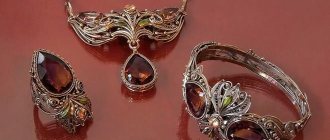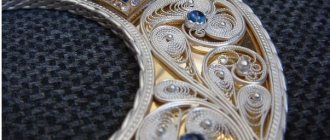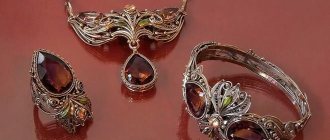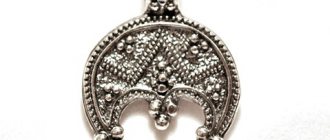Jewelry art of pre-Mongol Rus'
The remarkable art of ancient Russian jewelers of the era of Yaroslav the Wise and Vladimir Monomakh amazed European travelers who visited Rus' in those days. Over the centuries it was forgotten. However, through the efforts of domestic archaeologists in the 19th–20th centuries, the creations of ancient masters found a new life. Hundreds and thousands of jewelry created by craftsmen of the 10th - early 13th centuries were extracted from the ground. Exhibited in museum windows, they are capable of enchanting the modern fashionista and arousing the deep, sincere admiration of the artist.
In ancient times, Rus' was influenced by several developed cultures at once. In medieval Kyiv, entire neighborhoods were inhabited by foreigners: Greeks, Jews and Armenians. Severe warriors and clever traders from Scandinavia brought the subtle pagan art of the Viking Age to the Russian lands. Traders from the East - a colorful and intricate design that is so beloved in Islamic countries. Finally, Christianity, adopted from the powerful Byzantine Empire, located on the shores of the Mediterranean and Black Seas, connected Rus' with the high artistic culture of this state. Byzantium was at that time the beacon of civilization in barbaric Europe and the keeper of ancient knowledge bequeathed by the era of antiquity. But along with Christianity, Rus' preserved persistent pagan traditions for several centuries. The complex, highly developed religious system of East Slavic paganism became an important source of creative imagination of ancient Russian painters, sculptors and jewelers.
The jewelry art of Rus' reached its greatest flourishing in the 12th – 13th centuries.
Jewelry technicians
Ancient jewelers used the following special techniques:
- “filigree” or “filigree” - thin gold or silver wires intertwined with each other, flattened into a ribbon using a hammer, or drawn with gold wire to form an intricate pattern;
- “graining” is the fusing of many thousands of small metal beads onto a product, which creates an amazing play of light;
- “enamel” - the most widely known techniques of that time are, they were used both for decorating gold and silver items and for decorating books. There were two types of enamels - champlevé and cloisonné. It is cloisonné enamels that are considered the pinnacle of jewelry craftsmanship from the times of Kievan Rus. cloisonne enamel - a technique borrowed from Byzantium: a pattern in the form of partitions was applied to the surface of the products, and the space between them was filled with enamel, which was fired and polished;
- “engraving” was also widely used in the manufacture of jewelry and bore images of scenes from life, ritual pagan rites, mythical and real animals and birds.
All the skill of the craftsmen of that time can be appreciated if you give a few numbers. The Russian Museum of St. Petersburg houses silver kolta in the form of a semicircular shield with six silver cones. There are 5,000 tiny rings soldered onto each cone, and a grain of silver is soldered onto each ring! That is, just one colt contains 30,000 grains of silver. You can imagine the level of skill of this jeweler - after all, this is the 11th - 12th centuries!
Necklace (pendant). Ancient Rus'. 10th century Gold, enamel; forging, champlevé enamel, cloisonne enamel. Location: USA. NY. Metropolitan Museum of Art
Grand-ducal barmas from Old Ryazan. XII century. Gold, garnet, pearls, cabochons, enamel; granulation, pearl setting, openwork filigree, embossing, cloisonné enamel. Museum-reserve "Moscow Kremlin".
Fragment. Grand-ducal barmas from Old Ryazan. XII century. Gold, garnet, pearls, cabochons, enamel; granulation, pearl setting, openwork filigree, embossing, cloisonné enamel. Museum-reserve "Moscow Kremlin".
Tiara with a scene of the ascension of Alexander the Great. XII century. Gold, forging, soldering, enamel, pearls. Length - 35 cm. Discovered in 1900 as part of a treasure found on Devich Gora near the village of Sakhnovki. Collection of the Museum of Historical Treasures
Types of decorations
Cast silver rings with ornaments, twisted silver wire bracelets, glass bracelets and, of course, beads were in fashion. They were very diverse: from colored glass, rock crystal, carnelians and rubies, large hollow beads made of cast gold. Hanging from them were round or moon-shaped bronze pendants (lunars), decorated with subtle ornaments: unprecedented magical animals in the Scandinavian style, complex wicker structures, very reminiscent of the images on Arab dirhams - coins that were in circulation in those days both in Rus' and in Europe .
Rings, bracelets
Gold signet ring with the image of a lion. Ancient Rus', Kyiv. XIII century. From the personal collection of M. P. Botkin. It is the best example of all similar rings known in Rus'.
Gold ring. The settlement of Berestye. XIII century.
Twisted and plate bracelets. Lattice, slotted and ornament. plate rings. Moscow region
Folding bracelets - bracers, a silver bracelet-bracer from the site of Old Ryazan (excavations were carried out in 1966 by A. L. Mongait). The artifact dates back to the 11th–13th centuries, up to 1237 inclusive
Silver blackened bracelet-bracer with images of fantastic animals and birds. XII - XIII centuries. Treasure of St. Michael's Golden-Domed Monastery
Bracelet. 12th - 13th centuries. State museums of the Moscow Kremlin
Temporal rings
But the most popular decorations were temple rings or useryaz. Cast silver temple rings were woven into women's hairstyles at the temples or hung from headdresses; they were worn one or several pairs at a time.
More details can be found here: - Source 1 - Source 2 - Source 3
Each East Slavic tribe that became part of the Kyiv state had its own special type of temple rings, unlike the same decorations of its neighbors.
Northern women, for example, wore an elegant variety of rings that looked like a curl or a flattened spiral.
Rusborg 2016. Galina Klipert, 29 years old, lives in the city of Langepas, in the Khanty-Mansi Autonomous Okrug - Ugra. He works in a museum, where he runs the Russian costume workshop “Dushegreya” and organizes the festival of historical reconstruction “Taiga Outpost”. Its complex was made on the basis of finds at the Kvetun settlement. This is the chronicle city of Trubech, the northerners lived in it, in the 10th century it was the northern “outpost” of the northern land that became part of the Old Russian state, one might say, the border. Now Kvetun is a small village. In simple manuals for beginning reenactors, it is usually written that the northerners wore S-shaped temple rings, and the seven-rayed temple rings were worn by the Radimichi. But in reality this is not entirely true. Radimichi began to wear S-shaped temple rings only in the 11th century, and in the 10th century in one of the localities they wore seven-pointed, silver ones, and at the same time very beautifully decorated with ornaments. It is precisely these temple rings that are found in Kvetuni, and it was they that attracted me when I was choosing which complex to take for work. In general, the temporal rings of the Slavs are a whole world with its own individual patterns of development and characteristics, which is very interesting to study.
The Radimichs preferred the temporal rings, which had seven rays diverging from the arch, ending in drop-shaped thickenings.
On the temple rings of the Vyatichi, which were among the most decorative, there were seven flat blades instead of rays.
Vyatichi woman in a ribbon headdress with temple rings. Based on materials from Vyatichi burial mounds from the Moscow region, Drawing by Oleg Fedorov
Paired technical bead temple rings, second half of the 12th - first third of the 13th century. Rus. Gold; embossing, filigree, graining, soldering.
Temporal rings. 12th century Goes back to the ancient Slavic culture of the 7th - 8th centuries
Colts
Townswomen of the 11th–13th centuries. Most of all, they loved kolta - paired hollow gold and silver pendants, which were attached with chains or ribbons to the headdress. Many colts that have survived to this day are distinguished by their amazing perfection of shape.
In 1876, near the village of Terehovo, Oryol province, several pairs of kolts from the 12th - early 13th centuries were discovered in a rich treasure. They are massive five-pointed stars, densely covered with thousands of tiny soldered balls of metal. This type of jewelry technique is called granulation; it came from Scandinavia and was widespread in Ancient Rus'. Along with grain, filigree was also used: the thinnest silver or gold wire, twisted into strands, soldered onto plates or twisted into openwork patterns.
In 1887, on the territory of the ancient St. Michael's Golden-Domed Monastery, another treasure of jewelry from the 11th–12th centuries was found, including a pair of gold colts. The kolta were decorated with freshwater pearls and images of fantastic birds with women's heads. The colors of the images have not lost their brightness, and their combination is extremely exquisite: white, turquoise, dark blue and bright red. Meanwhile, the master who created this splendor died about eight centuries ago. Mikhailovsky kolta are made using the masterly jewelry technique of cloisonné enamel, which was adopted from the Byzantines. This forgotten art required patience and amazing precision in work. On the surface of the gold jewelry, the jeweler soldered the thinnest gold ribbons-partitions onto the edge, forming the outline of the future design. Then the cells between them were filled with enamel powders of different colors and heated to a high temperature. This produced a bright and very durable glassy mass. Products made using the cloisonné enamel technique were very expensive, so it is no coincidence that most of the works that have survived to this day are parts of expensive princely attire.
Star Colt 12th century. Material: Silver; casting, filigree, granulation Size: Height without pendant 11 cm; width 10 cm. Moscow Kremlin Museums
Russian woman in a headdress with kolta on cassocks and a headband, second half of the 12th century. Drawing by Oleg Fedorov
Old Russian woman in a headdress with kolta and three-bead rings, 12th century. Based on materials from a treasure from Old Ryazan in 1970. Drawing by Oleg Fedorov
Colts with images of birds. The turn of the XII–XIII centuries. Ancient Rus', Kyiv. Gold; embossing, engraving, filigree, soldering. From the personal collection of M. P. Botkin.
Colt. Ancient Rus'. XII century. Gold, cloisonne enamel.
Colt. Ancient Rus'. XII century. Gold, cloisonne enamel.
Holy martyr, unknown. Back side; Tree of Life. Colt; Russia. Kievan Rus; XII century; location: Russia. St. Petersburg, State Hermitage Museum (SE); 3.6×4.4 cm; material: metal gold, enamel; technique: forging, cloisonné enamel
Colt. Holy martyr. Ancient Rus'. XI century. Gold, pearls; casting, cloisonne enamel. Location: USA. NY. Metropolitan Museum of Art.
Colt St. martyr, unknown. back side
Sirens and the Tree of Life. Colt; Russia. Kievan Rus; XI century; location: USA. NY. Metropolitan Museum of Art (MetM); 5.7×6 cm; material: metal gold, enamel; technique: cloisonne enamel
Birds flanking the Tree of Life. Colt; Russia. Kievan Rus; XI century; location: USA. NY. Metropolitan Museum of Art (MetM); 5×5.3 cm; material: metal gold, enamel; technique: cloisonne enamel
Flanking birds. Tree of life. Colt. Ancient Rus'. XI century. Gold, enamel. Location: USA. Minneapolis. Museum of Russian Art
Colt. Tree of Paradise and birds; Russia. Kievan Rus; XI century; location: USA. NY. Metropolitan Museum of Art (MetM); 4.8×5.4 cm; material: metal gold, enamel; technique: cloisonne enamel
Colt. Tree of Paradise and birds; Russia. Kievan Rus; XI century; location: USA. NY. Metropolitan Museum of Art (MetM); 4.8×5.4 cm; material: metal gold, enamel; technique: cloisonné enamel (BACK SIDE)
Russian princess in an enamel headdress with a diadem and kolta, second half of the 12th - beginning of the 13th centuries. Based on materials from the Kyiv treasures. FIGURE by Oleg Fedorov
Pair of collets with images of birds. Front side. First half of the 12th century (?). Kyiv. Gold; embossing, engraving, filigree, mounting, soldering.
Colts from the Ryazan treasure. 12th century Gold, pearls, precious stones.
Mantle (Barmy)
The cross flourished. Suzdal mantle (barmy); Russia. Not installed; XII century; location: Russia. Moscow. State Historical Museum; 9.1 cm; material: metal silver; technique: engraving (carving), gilding, filigree, niello, stamping
Detail of a silver Suzdal mantle. 12th - 13th centuries. Silver; gilding, engraving, niello, soldering, granulation, filigree. From the excavations of A. S. Uvarov. Vladimir province, 1851. The monument was found during excavations by Count Uvarov of the burial mounds of the Suzdal district, near the village of Isada, located on the banks of the Nerl River, not far from Suzdal.
According to Uvarov’s description of the circumstances of the find, all the objects that make up the mantle were found in one of the mounds on the side, on the surface, so they were clearly only hidden in it and had nothing to do with the burial in the mound. The inventory of the mound also testifies to the same. The reconstruction of the original appearance of the mantle was made based on the objects found by Uvarov, mostly correctly, although the order of placement of the plaques and intermediate beads seems to be guesswork. The reconstructed Suzdal mantle is now stored in the halls of the archaeological department of the Historical Museum in Moscow.
Barms. Necklace of beads and medallion with the image of a flourishing cross. The end of the 12th - first third of the 13th century. Rus. Silver; embossing, filigree, graining, mounting, soldering, gilding, engraving.
Ryasny. Second half of the 12th century. Kyiv. Gold, pearls; embossing, cloisonne enamel, soldering.
Hryvnia
Gold hryvnia with enamel images of the Kamennobrod treasure.
Kamennobrodsky treasure. Found in 1903 in the Kyiv province. The circumstances of the find are unknown; the report of the Archaeological Commission states only that it was made by accident, “while digging up rock for stone cutting products.” The treasure's items were received by the Archaeological Commission, which handed it over to the Hermitage, from where it was transferred to the Ukrainian State Museums.
All images are made in cloisonne enamel, undoubtedly the work of a local Russian master, as evidenced by the nature of the inscriptions, which reveals a mechanical, with errors, copying of letters and syllables, as well as a characteristic folk alteration of the name “Peter” into “Petro”.
...the master’s desire for bright colors and a combination of abstract color patterns, which often subordinates the entire selection of tones for enamel coloring of images, is generally a characteristic stylistic feature of Old Russian enamels. This feature is particularly characteristic of things that are precisely the most advanced in the technique of making enamels and, therefore, cannot in any way be accidental, explained only by the inability of local craftsmen to follow Byzantine models and their principles of selecting colors for sacred images.
“Barbarian” art is characterized by a desire for bright colors and richness of color relationships in patterns made of valuable stones or glass colored alloys imitating them, placed on gold backgrounds of jewelry, utensils, horse harnesses and weapons. And this still living tradition of the artistic tastes of a barbarian society - doesn’t it explain to us the flourishing of the enamel work of ancient Rus', as we know it in the 11th and 12th centuries.
Gold hryvnia with enamel images of the Kamennobrod treasure. Fragment. First half of the 11th century.
"Chernigov hryvnia". 11th century Golden serpentine amulet with Archangel Michael
The central link of a golden diadem with the scene of the ascension of Alexander the Great. XII century. Gold, forging, soldering, enamel, pearls. Sakhnovsky treasure 1900
In Rus', the 12th century was a time of increased interest in depicting the scene of the Ascension of Alexander the Great, which was reflected both in decorative and applied art, as well as in monumental art. This plot was especially popular in ancient Russian white stone carvings, where it served as a symbol of the apotheosis of local rulers.
Collection of the Museum of Historical Treasures. "Belgorod hryvnia" Golden serpentine amulet. Around 1117. State Russian Museum. Saint Petersburg.
Lunnitsy
Lunnitsa is one of the most common amulets-amulets that existed for many eras and formed part of women’s attire. With all the variety of forms and techniques of execution, their common similarity with the Moon remains unchanged, personifying the lunar cult, fertility and femininity. Source: https://kulturologia.ru/blogs/021214/22391/
A woman in a headdress with grape-shaped earpieces, late 10th - early 11th centuries. Based on materials from treasures from Gnezdovo near Smolensk. Drawing by Oleg Fedorov
Silver lunar with filigree and grain, 10th–11th centuries.
Luna amulets with a cross
The production of moonlites goes back thousands of years. The first three-horned moons are known already in Bronze Age monuments. In the ancient period, golden crescent-shaped moons appeared, decorated with filigree decoration. In late Roman times, the crescent shape was widespread among the peoples of Europe and Western Asia. The early Chernyakhov lunnitsa originate from the territory of Eastern Europe. Enamel lunnitsa are characteristic of the Dnieper territories and belong to the Kyiv culture.
From the second half of the 9th century. Lunars appear in the culture of the Eastern Slavs and exist until the 13th century. Like ancient Russian pectoral crosses on the territory of Ancient Rus', lunar crosses became widespread already in the 10th–11th centuries. and in the XII–XIII centuries. are becoming the most popular among the decorations of the rural population, although, as recent studies have shown, lunnitsy cannot be considered a purely Slavic decoration. The appearance of two-horned lunas is associated with the penetration into the Slavic environment at the end of the 7th - beginning of the 8th century. complex of filigree-grained women's jewelry in connection with the first wave of Byzantine influence. The best examples of lunars are stamped silver ones, decorated with real grain, which are known from treasures of the 10th–11th centuries. In imitation of them, lunars with a pattern that copied the grain were cast from bronze and tin-lead alloys. Lunars were worn mainly as pendants to richly decorated necklaces along with temple decorations.
By the 12th century. include neck decorations, which could include more than ten different ancient Russian amulets, lunar pendants. In 1914, the first classification of lunites was published, developed by Vera Vladimirovna Holmsten. Its classification is based on the ratio of the length of the middle horizontal line to the distance between the horns. According to this classification, lunars are divided into wide-horned and narrow-horned, and according to the manufacturing technique - into stamped-filigree and cast. Silver wide-horned lunars of filigree-grained workmanship, known to us from treasures and individual rich burials of the local feudal nobility, are the products of Russian city jewelers of the 10th–11th centuries.
A woman in a headdress with grape-shaped earpieces, lunulae and shield-shaped pendants, late 10th – early 11th century. Based on materials from treasures from Gnezdovo near Smolensk. Drawing by Oleg Fedorov
Dishes
Chalice bowl. Ancient Rus', 12th century. Silver, embossing, carving, gilding
Chalice bowl. Novgorod, 1329. Jasper, silver, precious stones, carving, filigree, gilding
****************************************************************************
The Mongol-Tatar invasion turned out to be disastrous for many secrets of jewelry art. The masters who owned them disappeared during the hard times of Batu’s defeat or were kidnapped by the Horde to serve their rulers. For a whole century, the skill of ancient Russian jewelers was in decline, and only in the middle - second half of the 14th century. its slow revival began.
SOURCE:
Source 1
Source 2
Literature:
- S. M. Novakovskaya-Bukhman. Treasures of Ancient Rus' in the collection of the Russian Museum / The Russian Museum presents: Treasures of Ancient Rus' in the collection of the Russian Museum / Almanac. Vol. 457. St. Petersburg: Palace Editions, 2015, ISBN 978-5-93332-525-3
- Imperial Archaeological Commission (1859-1917): To the 150th anniversary of its foundation. At the origins of domestic archeology and protection of cultural heritage / Scientific. ed.-comp. A. E. Musin. Under the general editorship. E. N. Nosova. – SPb.: DMITRY BULANIN, 2009, ISBN 978-5-86007-606-8
0
Description[edit | edit code]
Saint George.
Byzantine enamel. X-XII centuries Old Russian jewelry craftsmanship from the times of Yaroslav the Wise and Vladimir Monomakh amazed European travelers visiting Rus'. Over the centuries it was forgotten. However, through the efforts of domestic archaeologists in the 19th-20th centuries, the creations of ancient masters found a new life. During excavations, hundreds and thousands of jewelry created by masters of the 10th - early 13th centuries were discovered.
In ancient times, Rus' was influenced by several developed cultures at once. In medieval Kyiv, entire neighborhoods were inhabited by foreigners: Greeks, Jews and Armenians. Warriors and traders from Scandinavia brought the pagan art of the Viking Age to Russian lands. Traders from the East - colorful and intricate designs in Islamic style. Orthodoxy, adopted from the powerful Byzantine Empire, connected Rus' with the high artistic culture of this state. Byzantium in those days was the core of the civilized world, adjacent to barbarian Europe and the keeper of ancient knowledge bequeathed by the era of antiquity. But along with Orthodoxy, Rus' preserved stable pagan traditions for many centuries. The complex, highly developed religious system of East Slavic paganism became an important source of the creative imagination of ancient Russian painters, sculptors and jewelers.
The Mongol-Tatar invasion turned out to be disastrous for many secrets of the jewelry art of Ancient Rus'. The masters who owned these secrets died or disappeared during Batu’s defeat or were kidnapped by the Horde to serve their rulers. For a whole century, the skill of ancient Russian jewelers was practically in decline, and only in the middle - second half of the 14th century did its slow revival begin.
Helmet of Yaroslav Vsevolodovich[edit | edit code]
Helmet of Prince Yaroslav Vsevolodovich - father of Alexander Nevsky.
Main article
:
Yaroslav Vsevolodovich (Prince of Vladimir)
In one of the showcases of the Armory Chamber of the Moscow Kremlin, an ancient helmet is displayed, the iron of which has rusted, and only the silver plates still shine with pure brilliance. On the plates decorating the top of the helmet are stamped images of Jesus Christ, Archangel Michael and selected saints. The work belongs to Novgorod masters and was performed at a high artistic level. The history of the helmet itself is connected with important political events. In 1216, on the Lipitsa River, near Yuriev Polsky, two Russian armies met - Novgorodians and Suzdalians with numerous allies. The battlefield was abundantly watered with the blood of warriors who belonged to the cities and principalities of half of Rus'. The leaders of Suzdal, and among them Prince Yaroslav Vsevolodovich, the father of Alexander Nevsky, were confident of victory. Shortly before the start of the battle, Yaroslav Vsevolodovich and his brother Prince Yuri Vsevolodovich exchanged armor according to ancient custom. The crushing defeat forced them to seek salvation by fleeing the battlefield. Yuri, not remembering himself from fear, took off his heavy chain mail and helmet and hid them until better times. The vanquished remained alive and retained princely power, but they were unable to find expensive weapons.
Techniques for making objects with cloisonné enamel
The sequence of operations for the production of high-quality cloisonne enamels is described in detail by Theophilus. He indicated that one should begin by preparing the thinnest plate of gold. This art has been known since the existence of ancient states, where the skill of artisans, who were called goldsmiths or bratiarii, was famous. The task of gold miners was to flatten gold or silver using a hammer. Then the resulting sheet was cut into several parts, which were folded into a stack lined with pieces of parchment. The stack of sheets was again subjected to hammer blows until a thin plate of gold was obtained. After this operation, the size of the plate increased to twice its original size.
The next operation is to give the desired shape to the plate using a stencil and matrix. For example, the plate could be shaped like a kolta, that is, a pendant for a woman’s headdress. Theophilus described working with the stencil and matrix as follows: a stencil with the contours of the desired design was applied to the matrix, and a recess was imprinted on a gold plate, which served as a tray for the enamel. Further actions were as follows: “... you will cut them into the shape that you want to fill with enamel... you will very carefully and carefully place these leaves in their places and, having attached them with flour glue, place them over the coals. When you have filled one part, you strengthen it with extreme care so that all the delicate work does not melt.” Theophilus advised checking whether enamels of different colors could melt at the same time in order to prevent mixing of paints.
During excavations of monuments of Ancient Rus', stencils for making kolts were discovered in Kiev in 1907 (archaeologist V.V. Khvoika), and matrices for giving the plate a convex shape were found in different years in many places (G.F. Korzukhina; B.A Rybakov; T.I. Makarova).
Names on metal[edit | edit code]
The names of the authors of most monuments of jewelry art of Ancient Rus' are unknown. Archaeologists, finding the remains of workshops that belonged to ancient Russian gold and silversmiths, extracted from the ground all the supplies necessary for the jewelry craft. However, history has not preserved the names of the wonderful craftsmen who created the “Chernigov hryvnia” or the kolta from the Mikhailovsky treasure. Sometimes only the jewels themselves “let slip” about their creators. Yes, craters
- precious silver bowls for holy water, created in medieval Novgorod of the 12th century, bear inscriptions that give the names of the masters Costa and Bratila.
The famous Polotsk enlightener of the 12th century, Princess Abbess Efrosinia, ordered a cross in 1161 as a contribution to the Spassky Monastery she founded. The six-pointed cross, about half a meter high, was made of cypress wood and covered at the top and bottom with gold plates decorated with precious stones. By the 20s of the 20th century, almost all the stones were lost, but it is known that there were about two dozen of them, and among them were garnets. The stones were mounted in sockets on gold plates, and between them the master inserted twenty enamel miniatures depicting saints. The name of each saint is minted next to the image. Christian relics were kept inside the cross: the blood of Jesus Christ, pieces of the relics of Saints Stephen and Panteleimon, as well as the blood of Saint Demetrius. The shrine was covered with gilded silver plates, and the edges of the front side were framed with a string of pearls. In the eyes of believers, relics made the cross more valuable than the gold and silver used by the jeweler.
The fate of the cross of St. Euphrosyne of Polotsk, which in turn was in the hands of Orthodox, Catholics, Uniates, in the treasury of the Moscow sovereigns and the cache of the French who occupied Polotsk in 1812, is sad. It was lost during the Great Patriotic War of 1941 - 1945; journalists, writers, scientists, politicians and even Interpol (International Crime Control) were looking for it. The history of these searches is as dramatic and inconclusive as, for example, the epic associated with the famous Amber Room (the walls and all the furnishings were decorated with amber), stolen by the Nazis during the Great Patriotic War and since then unsuccessfully sought by scientists.
Descriptions and drawings made before the disappearance of the cross of St. Euphrosyne preserved the text of the inscription that was left on the surface of the cross by its creator, the Polotsk master Lazar Bogsha (Boguslav). The Cross of St. Euphrosyne is one of the main spiritual shrines of Belarus and a recognized masterpiece of medieval jewelry.
Nowadays, temple rings, colts and many other works of medieval Russian jewelry are collected in museums. Particularly rich collections belong to the State Historical Museum, the Armory Chamber of the Moscow Kremlin and the Patriarchal Sacristy.
Hryvnia of Vladimir Monomakh[edit | edit code]
Main article
:
Vladimir Monomakh
Some monuments of ancient Russian jewelry art, which appeared before the Tatar-Mongol invasion, gained enormous fame. The most famous is the “Chernigov hryvnia”, or “the hryvnia of Vladimir Monomakh”. This is a chased gold medallion of the 11th century, the so-called “serpentine”, on one side of which a female head is depicted in a ball of eight snakes, symbolizing the devil, a pagan deity or the evil spirit in general. A prayer in Greek is directed against the disease. On the other side is the Archangel Michael, called upon to protect the owner of the hryvnia from the devil’s machinations. The inscription, made in Slavic letters, reads: “Lord, help your servant Vasily.” It was a real Christian amulet against evil spirits. The plot and the very technique of performing the serpentine torcs were borrowed from Byzantium; Before the Tatar-Mongol invasion, decorations of this kind were not uncommon. The “Chernigov hryvnia” was made with extraordinary skill and must have belonged to a rich, noble person, most likely of princely origin. The cost of this jewel is equal to the size of the princely tribute from an average city. The medallion was found in 1821 near the city of Chernigov, which in ancient times was the capital of the principality.
Hryvnia of Vladimir Monomakh. XII century. State Russian Museum, St. Petersburg.
The inscription indicating the identity of the owner - Vasily - told historians that the hryvnia belonged to Vladimir Monomakh (1053-1125), who was given the name Vasily at baptism. This famous ancient Russian commander and politician reigned for some time in Chernigov. He left a “Teaching” to the children, written in the form of memoirs. In this essay, the prince wrote that one of his favorite pastimes was hunting. When going out onto it, Vladimir Monomakh was not afraid of boar tusks and elk hooves. While hunting not far from Chernigov, he dropped a precious hryvnia, which brought to posterity the work of skilled Kyiv craftsmen.
Studying the issue of Old Russian cloisonné enamel
Researchers studying the development of the art of cloisonne enamel in Rus' most often cite the book of the German monk or presbyter Theophilus “Treatise on Various Crafts” (11th century) as a source. Theophilus noted the achievements of Rus' in the complex matter of using cloisonne enamel and gave a detailed description of the sequence of technological operations in its manufacture. Theophilus' book contains information about the design of the furnace for making enamel, the process of firing the product, possible errors and methods for correcting them. The final stage of the process is described in detail - polishing the product, which requires certain skills and abilities. The only drawback of Theophilus's work is that the book did not say anything about how the necessary drawing was created.
The first scientific works, which provide an analysis of the origin of cloisonne enamel in Rus' and a description of jewelry with enamel, appeared in the middle of the 19th century. In 1853, Russian historian, archaeologist and collector I.E. Zabelin (1820-1908), called products with cloisonné enamel “works of Russian masters, students of the Byzantine Greeks.” Thus, a scientific direction in historiography was established, emphasizing the Byzantine influence on the development of Russian art of cloisonne enamel. The broad goal of Zabelin’s research is the history of metalworking in Rus' from the pre-Mongol period to the 18th century. – did not allow the author to dwell in detail on the description of the technology for making jewelry with enamel in Kievan Rus, but the topic aroused interest.
In 1861, a book by the famous Russian archaeologist and art historian G.D. was published. Filimonov (1828-1898) “The frame of the Mstislav Gospel”, where the author presented a detailed description of the frame with various enamel decorations. The scientist came to the conclusion that the enamel on the skillfully made frame belonged to different times of manufacture, starting from the 12th century.
Unfortunately, the author’s task did not include a detailed analysis of enamel, study of their designs and the technology of their production. G.D. Filimonov believed that the study of Russian-Byzantine enamel production represented a wide field for further research.
A complete analysis of enamel products was carried out by Russian archaeologist and art historian N.P. Kondakov in 1892. The scientist traced the history of the emergence and spread of cloisonne enamel, starting with ancient Egyptian and ending with ancient Russian. He came to the conclusion that Rus' adopted Byzantine and Eastern techniques, enriching their skills with them. Like Zabelin, Kondakov emphasized the importance of Byzantine influence on the development of Russian enamels production, but believed that the necessary basis for such development already existed in Rus'. Kondakov’s book “History and Monuments of Byzantine Enamel” is still considered the most complete and valuable work on the history of enamel.
An invaluable contribution to the study of cloisonne enamels was made by the Soviet and Russian archaeologist, researcher of the culture of Ancient Rus', academician of the Russian Academy of Sciences B.A. Rybakov (1908-2001). In the book “The Craft of Ancient Rus'” (1948), Rybakov considers the production of enamel as a special branch of artistic craft that independently developed in Rus'. Rybakov’s painstaking work on studying images from cloisonne enamel is presented in the work “Russian Applied Art” (1971). Considering the issue of Russian applied creativity, the academician came to the conclusion that artistic crafts in Rus' did not lag behind those of Western Europe in terms of craftsmanship, and in some areas even surpassed it.
Soviet archaeologist, researcher of culture and crafts of Rus' G.F. Korzukhina (1906-1974) compiled a collection of 175 archaeological sources on enamels, and devoted a number of articles to treasures and the technique of making cloisonne enamel.
A generalizing work on cloisonne enamels was compiled by the Soviet and Russian archaeologist and cultural historian T.I. Makarova (1930-2009), who classified ancient Russian treasures and developed a chronology of the development of cloisonné enamel production technology in Rus'.
Vladimir cloisonne enamel
The development of enamel work in Vladimir can be judged only by two discovered jewelry: these are two pairs of Colts. Their production shows the influence of the Kyiv school of enamellers, but at the same time they are distinguished by their originality, indicating the presence of their own, Vladimir, school. The main product of local workshops was, obviously, church utensils. In the chronicles she was called in one word “finipt”. So, in the Ipatiev Chronicle, it is said about the order of Prince Andrei Bogolyubsky to decorate the Church of the Nativity of the Virgin Mary with “great priceless pearls, gold and finipt.” The description of the church “finipt” has not reached us, but what is noteworthy is the fact that “finipt” is on a par with precious stones and gold.
The connection between the Vladimir school and the Kyiv school is shown by the images of Saints George and Dmitry, especially revered in Vladimir, found on two found kolta. The continuity of traditions can be seen in the techniques used to convey the clothes of saints, and in the geometric shapes used for design. But there are also differences: the shape of the Vladimir kolts is marked by originality, and the design is more rough than the Kiev one. The color palette of Vladimir cloisonne enamel bore the imprint of local traditions. The attempt of Vladimir masters to reproduce the complex ornament of Kyiv enamels was not entirely successful: the splendor of the design could not be accurately reproduced.











